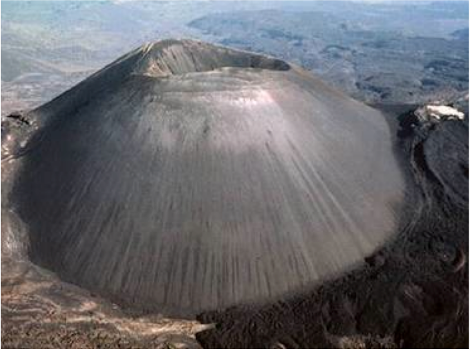Parícutin A Mountain in a Year
Reprinted with permission from Creation Ministries International (creation.com).
In 1943, a Mexican farmer was working in a field with his wife and son when he was astonished to see a small fissure suddenly open up in the ground in front of him. The trio were then rocked by a thunderous roar which shook the trees. The soil around the fissure bulged upwards 2 metres (6 ½ feet), the crack gaped wide open, and ash began blasting out. An horrific wailing or whistling sound commenced, building in intensity, and the air was quickly filled with dark ‘smoke’ and acrid vapours smelling of rotting eggs (hydrogen sulfide H2S). It was as if the end of the world had begun.

In the farmer’s own words: “I then became greatly frightened ... I couldn’t find my wife, or my son, or my animals. At last I came to my senses and I remembered the sacred Lord of the Miracles. I shouted out ‘Blessed Lord of the Miracles, you brought me into this world— now save me!’ ... I looked into the fissure where the smoke was rising and my fear disappeared for the first time ... I mounted my mare and galloped to [the village of] Parícutin where I found my wife and son and friends waiting for me. They were afraid that I was dead and that they would never see me again.” 1
A volcano begins
The farmer’s name was Dionisio Pulido, and he had just witnessed, with his wife Paula, the birth of a completely new volcano. The volcano came to be known as Parícutin, after his village. Within hours of Dionisio’s narrow escape, a dark ‘scoria’ 2 cone began rising ominously from the field, and in a week it had grown to 100 metres (over 300 feet) high. Lava started to flow soon afterwards, and in a month the volcano was a major feature that could be seen from far away. It continued to grow bigger still, and the villages of Parícutin and San Juan Parangaricutiro were destroyed.
No one was killed directly by the lava flows or hot ash but three people died after being hit by lightning caused by the pyroclastic ash clouds. Thousands of farm animals perished. The size and impact of the new volcano was so great that the people and animals from the villages and farms all around had to be permanently moved to a new locality.
In modern times, there have been many eruptions of pre-existing, once-dormant volcanoes, but Dionisio’s mountain is especially notable because its very beginning had eyewitnesses. It was also the first time that scientists were able to observe the complete lifecycle of a volcano. Parícutin reached the height of 336 metres (1,100 feet) in the first year, and when it ceased erupting in 1952 it had grown to be 424 metres (1,390 feet) high above the plain (elevation [i.e. above sea level] is 2,800 m [9,186 ft]). It is now considered to be extinct. 3 What began as a tiny crack in the ground, right before the eyes of an amazed farmer, is today a major geographical feature called one of the seven natural wonders of the world, and attracting tourists and climbers from far and wide.
Millions of years not needed
Most of the world’s major geologic features did not have human witnesses to their formation. 4 Uniformitarian scientists have inferred what happened in the past in the light of their long-age philosophy. They assert that most geological features took many thousands or millions of years to form. Yet we know from actual eyewitness testimony that Mount Parícutin took only 9 years to form, from beginning to extinction, with most of its growth having occurred in the first year. With much larger forces at work in the earth’s crust, as occurred during the terrible year of the global Flood, even the largest geographical features we see in the world today would have formed in months, weeks or even days.
|
- 1The eruption of Parícutin (1943–1952), geology.sdsu.edu, parentheses added, accessed 25-5-12.
- 2Rough fragments of hardened, cindery lava ejected from a volcanic vent.
- 3Volcanoes that are considered unlikely to erupt again are commonly called ‘extinct’. According to uniformitarian orthodoxy, extinct volcanoes are usually considered to have last erupted during a supposed prehistory, millions of years ago.
- 4Even Noah, aboard the Ark, could not see what was happening beneath the surface of the floodwaters. Of course, having been informed by God, and knowing what the world was like both before and after the Flood, Noah would have been very aware of the vast magnitude of change that had occurred in the world.
- 5Walker, T., Looking into the Glass House Mountains, Australia, Creation, 31(4):54–55, 2009, creation.com/glass-house-mountains-australia.